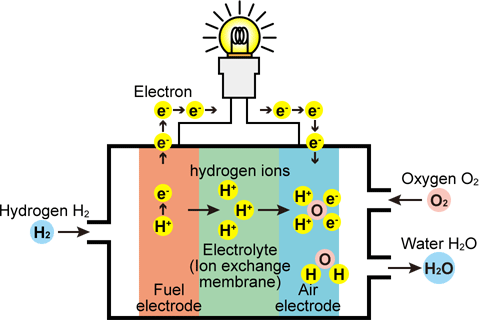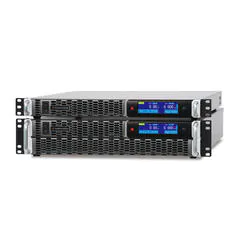
How Fuel Cell Works
Fuel cells generate electricity through an electrochemical reaction known as reverse electrolysis. A fuel cell is a device that generates electricity directly from a chemical reaction between hydrogen (H2) and oxygen (O2). The fuel cells do not need to be periodically recharged like batteries or convert energy obtained from combustion into electricity like a generator. Instead, continue to produce electricity as long as a fuel source is provided.
Fuel cell power generation is the reverse of electrolysis of water (H2O). In water electrolysis, when a voltage is applied to the electrolyte, the hydrogen ions (H+) of water are given electrons (e-) to become hydrogen, and the hydroxide ions (OH-) are deprived of electrons to become oxygen and water.
A fuel cell, on the other hand, is composed of an anode, a cathode, and an electrolyte. Hydrogen gas is delivered to the anode (fuel electrode). At the anode site, the hydrogen molecules are separated into hydrogen ions (protons) and electrons. The hydrogen ions pass through the porous electrolyte membrane toward the cathode while the electrons are forced through a circuit, generating an electric current.
At the cathode, oxygen receives the electrons from the circuit to produce oxygen ions (O2-). The hydrogen and oxygen ions in the electrolyte then combine to generate water.

Due to its mechanism, fuel cells are very clean and completely carbon-free. These qualities make it an attractive fuel for power generation and many more applications.
Fuel Cell As Alternative Fuel
Fuel cells have the most significant potential for reducing greenhouse gas emissions as they do not emit carbon dioxide (CO2) when generating electricity. The fuel cells produce only water and have little impact on the environment. In other words, green energy can be used as a clean energy source.
In line with the 2015 Paris Agreement, Japan has set a target of reducing greenhouse gas emissions, including CO2, by 26% from the fiscal 2013 level by fiscal 2030. Japan still must continue to reduce CO2 emissions from thermal power generation using natural gas, coal, and oil for more than 70% of power generation, contributing to increasing CO2 emissions. The development and introduction of renewable energy sources such as solar and wind power are underway, but there are challenges to ensure stable supplies since it depends on climate.
As for power generators typically used in thermal power plants, water is heated by burning fuel, and the energy from turning the water to steam is used to turn a turbine to generate electric power. While its ability for large-scale power generation is advantageous, there have been disadvantages, such as high energy loss and the tendency for extensive facilities.
Meanwhile, fuel cells have less noise and vibration during power generation compared to typical power generators, and the fuel cell installation is completed in a short period. Unlike hydroelectric, thermal, and nuclear power plants, fuel cells are suitable for small-scale commercial facilities. This power generation is referred to as a distributed power source. It is expected to reduce transmission losses through local production for local consumption of energy, which contributes to the revitalization of the regional economy.
As fuel cells generate heat for power generation, the waste heat is used to produce water as secondary energy usage, which is one of the most advantages of fuel cells. If the hydrogen is produced from fossil fuels, but the amount of CO2 per unit of heat generated is less than that of other power generation, such as thermal power generation.
Types of Fuel Cells
The fuel cells have unique characteristics according to the power generation methods and applications. The four types of fuel cells below are commonly available for practical use.
Polymer Electrolyte Fuel Cell (PEFC)
In Japan, Polymer Electrolyte Fuel cells are mostly used in the practical application of home fuel cell systems such as Ene-Farm and fuel cell vehicles.
It uses proton-conducting polymer membranes as the electrolyte.
As for household fuel cells, hydrogen extracted from the city gas is used as the fuel.
The fuel cells operate at relatively low temperatures (70 to 90℃) while the power generation efficiency is low at 30 to 40%, and hot water can be supplied using the exhaust heat.
https://www.aisin.com/jp/product/energy/cogene/enefarm/
Phosphoric Acid Fuel Cell (PAFC)
The Phosphoric Acid Fuel Cell (PAFC) is used in cogeneration applications for factories and offices. It is used in food factories and semiconductor plants.
The PAFC employs a plate of sintered silicon carbide powder impregnated with concentrated phosphoric acid as the electrolyte.
The power generation efficiency is 35 to 42%, and the operating temperature is around 180 to 200℃.
http://jser.gr.jp/kaiin/JSER_BOOK/2000/21-402.pdf
Molten Carbonate Fuel Cell (MCFC)
The Molten Carbonate Fuel Cell (MCFC) is essential to replace high-output power generation equipment such as thermal power plants.
The MCFC uses a molten carbonate salt suspended in a porous ceramic matrix or other substances used as an electrolyte.
While the power generation efficiency is as high as 40 to 50%, the operating temperature is as high as 600 to 700℃.
Water supply authorities take the initiative of pilot introductions of the MCFCs.
https://www.neomag.jp/mailmagazines/topics/letter201309.html
Solid Oxide Fuel Cell (SOFC)
The Solid Oxide Fuel Cell (SOFC) is also used as high-output power generation equipment.
The SOFC employs zirconia ceramics in electrolyte materials.
Development is underway for home and automotive applications.
It operates at temperatures as high as 700 to 1,000℃ with a high power generation efficiency of 40 to 65%.
https://www.nedo.go.jp/hyoukabu/articles/201215osakagas/index.html
https://xtech.nikkei.com/atcl/nxt/column/18/01537/00550/
Future of Fuel Cells
The fuel cell systems are the best against global warming, considering climate change due to the huge consumption of fossil fuels. The development of green energy should be encouraged much more around the world. Small fuel cells are particularly suited for small-scale power generation and attract attention as an emergency power source for data centers and public facilities.
Natural disasters like earthquakes and typhoons often hit Japan, and many municipalities and offices are taking countermeasures by installing small-scale private power generation systems in the event of a power failure for a long period. Fuel cells have a lot of potential when it comes to power generation applications.
Small and lightweight fuel cells may power portable devices that currently use mobile batteries.
Smart cities, a sustainable framework consisting of ICT and other new technologies, are increasing in Japan. Fuel cells are being used extensively in smart cities and other demonstration experiments. Kobe City initiated "the Hydrogen Smart City Kobe Plan" to support innovative technology developments. Kyushu University's Ito Campus focused on hydrogen energy research. More and more have joined the smart city solutions.
For example, in the demonstration experiment, filling solar cell vehicles with hydrogen at hydrogen stations and using the fuel cell vehicles not only as a means of transportation but also as a battery and a power supply source for homes and equipment.
However, because of the need for more infrastructure to support the hydrogen supply network, many businesses only have to implement fuel cell utilization in coastal areas experimentally.
In addition to producing hydrogen from fuel gas, research is underway regarding biogas usage derived from food waste and fuel cells using methanol as the electrolyte without hydrogen.
As of 2023, it will take some time to put into practical use of methanol due to safety problems and catalyst service life.
Having said that, fuel cells offer various applications in different industries. Europe, North America, and other countries have joined fuel cell installation. In Germany, railway vehicles running on fuel cells have been introduced on an experimental basis. In the United States, fuel cell vehicles such as buses and trucks are being developed mainly for large vehicles.
However, using fuel cells has several drawbacks, including safety concerns and a need for more infrastructure to support the distribution of hydrogen. Fuel cells have strong potential for research and development of fuel cell technology, which will be seen as the future of green energy.
In the development of fuel cells, an electronic load is used to simulate power consumption. Electronic loads generally dispose of power as heat. It is a good substitute for heating in winter, but in summer, air conditioning or other power is needed to cool that heat.
Matsusada Precision's bidirectional DC power supplies regenerate power to the AC line during the electronic load operation to minimize heat generation. Our regenerative DC power supplies, such as the PBR series, can regenerate up to 120 kW, ideal for fuel cell development and evaluation. Furthermore, programmable DC power supplies, bipolar power supplies, high voltage power supplies, and other power supply equipment are available for fuel cells and fuel cell control units.
Related Technical Articles
Recommended products
Matsusada Precision's bidirectional DC power supplies regenerate power to the AC line during the electronic load operation to minimize heat generation. Our regenerative DC power supplies, such as the PBR series, can regenerate up to 120 kW, ideal for fuel cell development and evaluation. Furthermore, programmable DC power supplies, bipolar power supplies, high voltage power supplies, and other power supply equipment are available for fuel cells and fuel cell control units.






